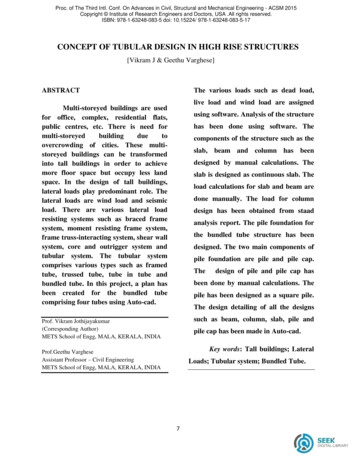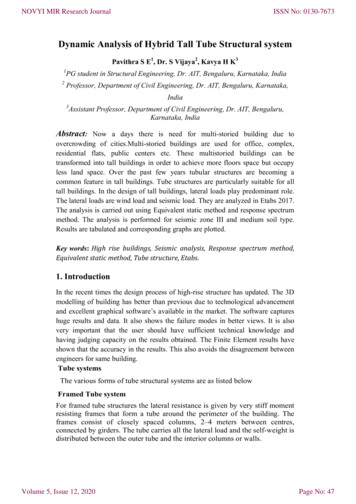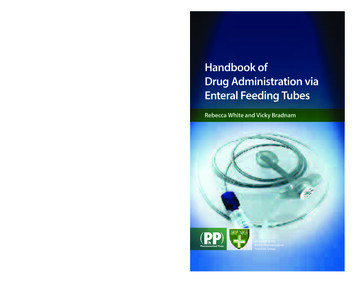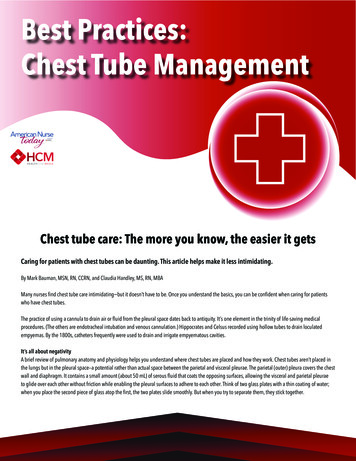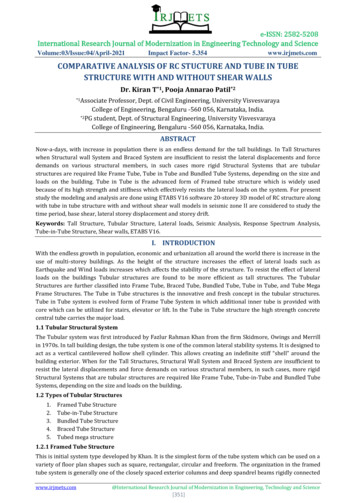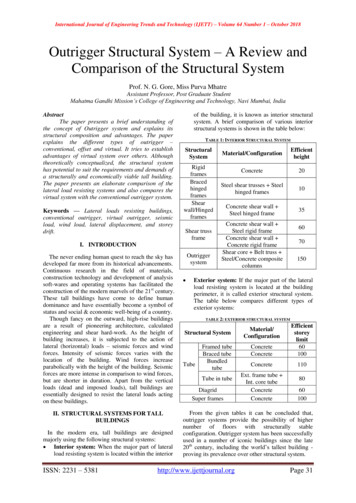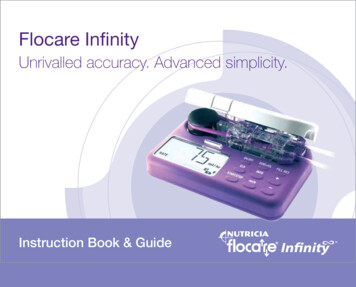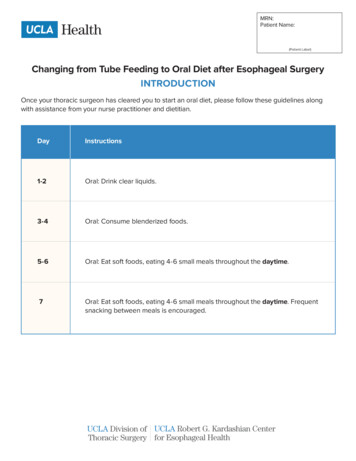
Transcription
MRN:Patient Name:(Patient Label)Changing from Tube Feeding to Oral Diet after Esophageal SurgeryINTRODUCTIONOnce your thoracic surgeon has cleared you to start an oral diet, please follow these guidelines alongwith assistance from your nurse practitioner and dietitian.DayInstructions1-2Oral: Drink clear liquids.3-4Oral: Consume blenderized foods.5-6Oral: Eat soft foods, eating 4-6 small meals throughout the daytime.7Oral: Eat soft foods, eating 4-6 small meals throughout the daytime. Frequentsnacking between meals is encouraged.UCLA Division of UCLA Robert G. Kardashian CenterThoracic Surgery for Esophageal Health
How to Manage Your Tube Feeding as You Start EatingAs you start eating and are able to increase your food intake, you can start reducing your tube feedingamount and time. This table can help you navigate through this process.Amount of Meals EatenTube Feeding AdjustmentsLess than 50% of mealsContinue your current tube feeding regimen.50% of most mealsReduce your tube feeding time by half.Example: If you run your tube feeding 16 hours per day, you canreduce it to 8 hours per day.50-75% of most mealsReduce your tube feeding time by a third.Example: If you run your tube feeding 12 hours per day, you canreduce it to 4 hours per day.75% or more of most ofyour mealsStop tube feeding and use oral nutrition supplements as needed.Remember that oral nutrition supplements also count! If you are able to drink an oral nutritionsupplement that is at least 250-300 calories and has at least 12 grams of protein per carton or bottle,you will be able to decrease your tube feeding time. For every can or bottle you drink, you can removeone can of tube feeding formula.Remember, changing from tube feeding to oral feeding is different for everyone and you may need moretime to adjust.Things to Consider1. If you are underweight or have poor nutritional status, then you might need to continue both oraland tube feedings.2. If you are still receiving chemotherapy, then it is best to continue tube feeds and keep the feedingtube in case you become dehydrated.3. If you have diabetes, then it is critically important to adjust diabetes medications and especiallyinsulin during the change from tube feeding to oral feeding to avoid low blood sugar. Close bloodsugar monitoring is very important if you are a diabetic.4. If you notice weight loss of 3% of your bodyweight, please contact us. For example: If you weigh 100 pounds, 3% of your body weight would be 3 pounds. If you weigh 150 pounds, 3% of the body weight would be 4 ½ pounds. If you weigh 180 pounds, 3% of your body weight would be 5 ½ pounds.UCLA Division of UCLA Robert G. Kardashian CenterThoracic Surgery for Esophageal Health
STAGE 1 – CLEAR LIQUIDSClear liquids are used as an initial step to reintroduce foods after your esophageal surgery. Clear liquiddiets consist of liquids that are transparent (you can see through them). A clear liquid diet alone does notprovide enough nutrients to meet your body’s nutrition needs, so it should be used less than 1-2 days orwith tube feeding.Foods RecommendedFoods NOT Recommended All others not listed in foodsrecommended.Water / ice chipsTranslucent fruit juices without pulp, such as apple, cranberry, grapeCrystal Light Broth or bouillonGelatinFruit ice, sorbet and popsiclesTea or coffee (sweetener and lemon ok for hot beverages, no dairy)Hard candiesSalt for flavorSoda (lemon-lime soda or ginger ale)Additional Suggestions This diet does not include dairy and dairy substitute items (soy, rice, almond, etc.) because they are notclear (you cannot see through them). You can take oral nutrition supplements such as Ensure Clear or Boost Breeze with other clear liquidsor between meals.Sample MenuBreakfastMid-Morning SnackLunchMid-Afternoon SnackDinnerAfter-Dinner Snack4 ounces cranberry juice12 ounces chicken broth4 ounces orange gelatinWater, ice8 ounces coffee8 ounces of Ensure Clear or Boost Breeze 4 ounces grape juice12 ounces beef brothWater, ice1 popsicle8 ounces tea8 ounces of Ensure Clear or Boost Breeze 4 ounces apple juice12 ounces of vegetarian broth8 ounces crystal lightWater, ice1 lemon sorbet8 ounces tea4 ounces grape juice1 fruit iceUCLA Division of UCLA Robert G. Kardashian CenterThoracic Surgery for Esophageal Health
STAGE 2 – BLENDERIZED DIETThe blenderized diet includes mostly liquids (including milk) and some foods with small amounts of fiber.The blenderized diet can provide many of the nutrients your body needs, but it may not provide enoughvitamins, minerals, fiber, protein or calories.This diet should only be used temporarily during your recovery until it is safe for you to eat regular foods.Your registered dietitian can help establish a nutritionally-balanced, blenderized meal plan, if needed.Most food can be converted to a blenderized consistency while adding calories/protein.How to Thin by Food TypeMeats, fish, poultry, porkBlend with broth, water, milk/milk substitute, tomato sauce,creamy soup, or gravy. The consistency must be drinkablethrough a straw and it should be free of solids that requirechewing or are difficult to swallow.VegetablesBlend with water, tomato juice, broth, and strain.Ready-to-use substitute: strained baby food vegetables.Starches (potato, pasta,beans)Blend with soup, broth, milk/milk substitute, water, gravy.Ready-to-use substitute: Hot cereals (Cream of Wheat/Rice ,grits).FruitsBlend with fruit juices, milk/milk substitute, and strain.Read-to-use substitute: strained baby food fruit.How to Increase Calories/Protein on Blenderized Diet Prepare cereals with whole milk/milk substitute, or commercial protein drinks. Blend butter or oil with starches, meats or vegetables for extra calories. Blend foods with broth instead of water for additional calories. Blend fruit with fruit juices instead of water for additional calories. Fortify most foods with unflavored protein powder, such as pea-based or brown-rice basedprotein powder. Drink nutritional shakes in 6-8 ounce servings in-between meals to make sure you’re taking inenough calories. You can make fortified shakes for yourself or buy them ready-made at a store. A high-protein shake should contain at least 8-10 grams of protein per serving. If you are preparingthe shake at home, you can increase the amount of protein by adding protein powder or dry milkpowder, soymilk, yogurt, or low-fat milk.UCLA Division of UCLA Robert G. Kardashian CenterThoracic Surgery for Esophageal Health
Food GroupFoods RecommendedFoods to Avoid DuringThis StageBreads, cereals, grains Thinned hot cereals likeCream of Wheat/Rice All grain foods includingwhole grains, processedgrains such as pasta, rice,cold cereals, bread, snacksand sweets that are flourbased (cakes, cookies)Vegetables Vegetable juice with orwithout pulp (well blended) Thinned, pureedvegetable soups Whole, frozen, fresh, cannedvegetablesFruits Translucent fruit juices withoutpulp (apple, cranberry, grape) Whole, frozen, fresh, cannedfruitsPlant-based proteinsources Pureed tofu, beans thinnedwith broth or other liquids Nut-based milk, oat milk,or coconut milk yogurt Nuts and nut butters All meat substitutes (suchas soy, firm/whole tofu) All cold cuts (such assalami, ham)Meats and other animalbased protein sources Pureed meats or poultrythinned with broth orother liquids Eggs or egg substitutes Soft cheeses Greek yogurt Oils Almond oil, avocado oil,canola oil, cashew oil, cornoil, grapeseed oil, olive oil,safflower oil, sesame oil,soybean oil, sunflower oil Butter, soft tub margarine thatdoes not contain trans-fat(melted or blended into foods) Lard, oils with trans-fatOther Seasonings, ground spicesand smooth condimentsas tolerated Gravies and sauces,tartar sauce Condiments with chunks,piecesBeveragesAllNoneBeef and pork (all cuts)Chicken and turkey (all cuts)Fish (all types)Eggs (all types)Hard cheeseYogurt with fruit chunksUCLA Division of UCLA Robert G. Kardashian CenterThoracic Surgery for Esophageal Health
Sample MenuBreakfastMix well in a blender and then strain1 cup cooked oatmeal1 cup 2% milk or milk substitute1 teaspoon cinnamon1 teaspoon brown sugar1 teaspoon of oil or coconut milk (optional for additional calories)Mid-Morning SnackMix well in a blender and then strain“Egg nog” made with 1 cup liquid pasteurized eggs (such asEgg Beaters )1 very ripe banana, mashed1 cup whole milk or milk substitute1 teaspoon vanilla1 teaspoon nutmegLunchMix well in a blender and then strain2 cups your choice of cream soup¼ cup tender-cooked chicken or 2 scoops protein powder ofyour choice½ cup mashed potatoes½ cup cooked vegetablesMid-Afternoon Snack12 ounces ready-made liquid supplement, such as CarnationBreakfast Essentials , Boost /Ensure , Orgain or othersimilar productsDinnerMix well in a blender and then strain1 cup pasta sauce2 ounces tender-cooked meat or plant-based meat substituteor tofu1 cup cooked pastaEnough vegetable juice to make the blended food drinkable,if neededAfter-Dinner SnackMix well in blender (or stir well)2 cups blended ice cream of your choice with 1 cup milk ormilk substituteUCLA Division of UCLA Robert G. Kardashian CenterThoracic Surgery for Esophageal Health
STAGE 3 – SOFT FOODSSoft foods are moist, soft-textured and are easy to chew and swallow. Foods that are hard or crunchyshould be avoided during this stage. Most foods that are harder can be chopped, moistened, and/orcooked longer to help them become softer and easier to eat and tolerate.Food GroupFoods RecommendedFoods to Avoid During This StageBreads,cereals,grains Soft white or wheat bread without seeds,dried fruit, nuts or crust Tortillas Hot cereals like oatmeal, Cream of Wheat/Rice Cold cereals that are soft after soaking in milk Pancakes and muffins Soft pasta, soft rice, polenta Potatoes, yams, sweet potatoes without skins Breads containing nuts, seeds, ordried fruit Tough or crusty-top breads likeFrench or baguette Cereals containing dried fruit or nuts Cereals that do not soften whensoaked in milk Potatoes and similar starchyvegetables with skins Pasta or rice that is hard or “al dente”Vegetables Well-cooked, soft vegetables without seedsor skins (mashed potato, squashes) Finely chopped cooked greens All raw vegetables Cooked vegetables with skinsand/or seedsFruits Applesauce, ripe soft banana, canned soft fruit,soft fruit cups Mashed avocado Unripe fruit with seeds and skinsPlant-basedproteinsources Mashed beans, lentils, and other legumes(hummus) Soft or firm tofu Creamy nut butters Nut-based milk, oat milk, or coconut milk yogurt Nuts and seeds Crunchy nut butters Cooked or canned beans in thewhole form Extra firm tofuMeatsand otheranimal-basedproteinsources Ground or chopped, moist meats or poultry(chicken salad) Flaked fish without bones (tuna salad) Eggs or egg substitutes (egg salad) Soft cheeses (ricotta, cottage) Greek yogurt Whole cut, tough, stringy meats,poultry, and fish Hot dogs and sausagesOils Almond oil, avocado oil, canola oil, cashew oil,corn oil, grapeseed oil, olive oil, safflower oil,sesame oil, soybean oil, sunflower oil Butter, soft tub margarine that does not containtrans-fat (melted or blended into foods)NoneOther Seasonings, ground spices and smoothcondiments as tolerated Gravies and sauces, tartar sauce, relish,chopped olives Popsicle Strained cream soups Popcorn, potato chips, corn chips Whole pickles, whole olivesBeveragesAllNoneUCLA Division of UCLA Robert G. Kardashian CenterThoracic Surgery for Esophageal Health
Additional Suggestions Eat small, frequent meals, about 5 to 6 per day, to help with tolerance and better food intake. Avoid rushing through meals. Chew well and take your time. If you feel full quickly, try to eat protein-rich foods first. If you are unable to eat enough protein, trymixing a protein powder supplement with foods that are not protein-rich. The protein powder shouldhave at least 10 grams of protein per scoop. Drink liquids between meals and not with your food. Use oral nutrition supplements such as Ensure , Boost , or Kate Farms between meals; always closerto the meal you just had and far away from the next one. If you are able to drink one or two of themdaily, you may be fine to reduce your tube feeding time. If soft foods are still hard for you to swallow and digest, consider trying more pureed foods as anintermediate stage. Any of the soft foods above can be pureed by adding liquids as needed, likesoups and sauces, and using a blender or food processor. You can also try baby foods if you get tiredof meal prepping. Contact your registered dietitian for more ideas and to make sure you are gettingenough nutrition.Sample MenuBreakfast½ cup diced peaches1 scrambled egg½ cup Cream of Wheat/Rice (mix in a serving of protein powderif you do not eat the egg)1 cup milk or milk alternativeMid-Morning Snack½ cup applesauce2 spoons of smooth nut butterOral nutrition supplement if ableLunch3 ounces of meatloaf with gravy or tofu with your favorite sauce½ - ¾ cups of mashed potatoes½ cup soft cooked baby peas¾ cup creamy soup (optional)Mid-Afternoon Snack1 cup of yogurt or yogurt alternativeOral nutrition supplement if ableDinner4 ounces soft, white boneless fish or mashed beans½ - ¾ cup soft rice with gravy, creamy soup, or sauce½ cup soft diced carrotsAfter-Dinner Snack½ cup cottage cheese or cheese alternative and ½ cup soft fruit cupOral nutrition supplement if ableUCLA Division of UCLA Robert G. Kardashian CenterThoracic Surgery for Esophageal Health
Amount of Meals Eaten Less than 50% of meals 50% of most meals 50-75% of most meals 75% or more of most of your meals Tube Feeding Adjustments Continue your current tube feeding regimen. Reduce your tube feeding time by half. Example: If you run your tube feedin
